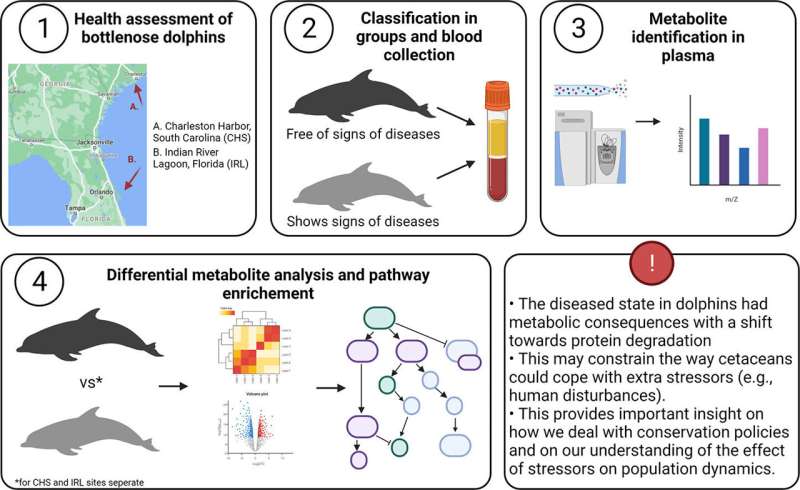Diseased dolphins at risk of starvation use muscles as energy source to survive

Diseased dolphin populations are using their muscles as an energy source to survive, a conservation study that analyzed their metabolism has found.
The study has found that due to man-made factors including tourism and shipping, those diseased dolphins may be put an an increasing risk of starvation. Disruption of feeding due to human activity in the ocean is one of many conservation concerns impacting all marine mammals.
Researchers from the University of Aberdeen, Medical University of South Carolina, Georgia Institute of Technology and the Technical University of Denmark have now compared the blood profile of diseased bottlenose dolphins with blood profiles of healthy bottlenose dolphins from wild populations at Charleston Harbor and the Indian River Lagoon, U.S.
By increasing the understanding of the dolphin's physiology, conservationists can better assess how to mitigate the risks posed by human activity.
The study, published in Comparative Biochemistry & Physiology, has found that dolphins with poorer health had lower levels of amino acids, the building blocks for muscles, may use those building blocks to substitute the shortfall in energy they have to fight the disease.
Dr. Patricia Fair from the Medical University of South Carolina and Dr. Davina Derous from the University of Aberdeen's School of Biological Sciences have said the study provides a vital benchmark for measuring the health of dolphin populations and will be highly effective in influencing conservation policy.
Dr. Davina Derous from the University of Aberdeen's School of Biological Sciences explains: "This study gives us vital insight into how diseased animals regulate their metabolism and how further impact by humans activities may cause even more issues to their health.
"Energy metabolism plays a key role in our ability to understand the consequences that human disturbances might have for the conservation of whale and dolphin species. Human activities can disrupt the foraging ability of these animals, reduce their food intake, and can impact how much energy they can invest in reproduction or growth. Predicting these ecological consequences is limited by our understanding of cetacean energy metabolism and what a healthy dolphin looks like.
"Human activities can impact the health of dolphins to such a degree that it can even lead to less offspring being born. To prevent this, we are measuring the health of dolphins by estimating how much fat they have. This is the same principle as in humans where we don't have enough fat stores, the body tries to survive by shutting down non-essential mechanisms such as our ability to reproduce. However, in dolphins we have found that only looking at their fat stores does not give us the full picture about their health, as they also use fat stores to keep them warm, to dive and for buoyancy. We desperately need novel health markers if we want to protect these precious species. Our study is the first step towards finding those novel health markers."
Prof David Lusseau from the Technical University of Denmark National Institute of Aquatic Resources continues: "When in good 'health,' individuals might be able to accommodate exposure to stressors but when in poor health, individuals will lack the resilience to cope physiologically and/or behaviorally with those stressors and their effects will impact life functions. Our results show that this might indeed be the case and that dolphins may struggle in time to have the energy necessary to both survive and keep producing offspring."
More information: Davina Derous et al, Untargeted plasma metabolomic analysis of wild bottlenose dolphins (Tursiops truncatus) indicate protein degradation when in poorer health, Comparative Biochemistry and Physiology Part D: Genomics and Proteomics (2022). DOI: 10.1016/j.cbd.2022.100991
Provided by University of Aberdeen
















